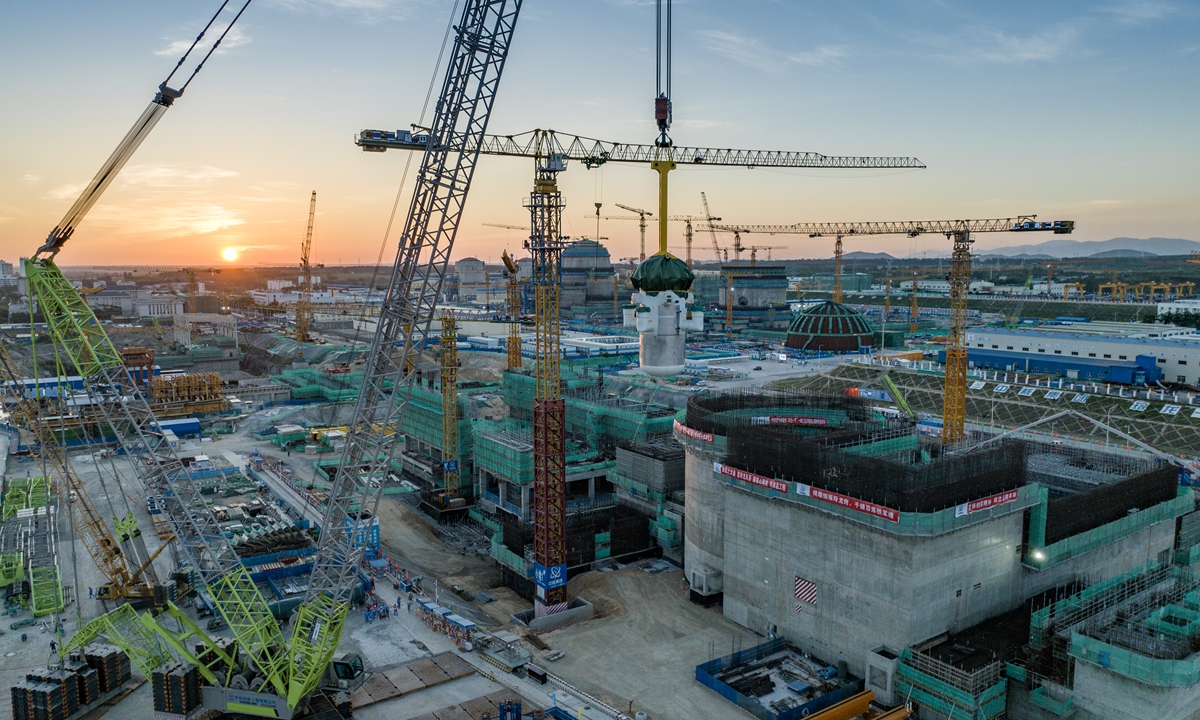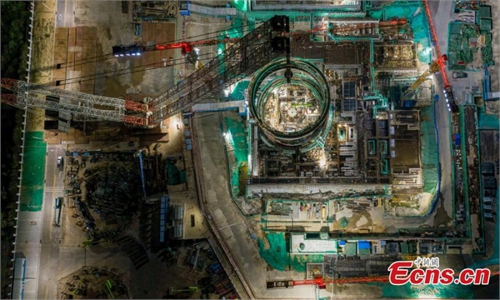
Linglong-1 Photo: CNNC
After a three-hour drive from Sanya, Global Times reporters, along with approximately 200 officials and scholars, arrived at the Changjiang Nuclear Power Plant in South China's Hainan Province on Tuesday morning. This facility is the base for the Linglong-1 - the world's first commercial onshore small modular reactor (SMR) to begin construction and pass the IAEA general safety review.
Many foreign representatives from the nuclear power industry, particularly from countries keen to introduce nuclear energy, eagerly anticipate this tour. They hope to learn more about this significant example of nuclear energy innovation and evaluate if the Linglong-1 might be a suitable choice for them.
Donning long-sleeve shirts, pants, smash-proof shoes, and safety helmets, visitors were ushered to the construction site in groups. Safety warning signs were prominently displayed throughout the site, underscoring the importance of safety during construction.
The entire project is slated to commence the installation phase by the end of 2023. With safety and quality thoroughly monitored, the project is set to transition to the debugging stage in the second half of 2024, according to Qu Yong, the deputy-chief-engineer of Hainan Nuclear Power. Earlier in August, the core module was installed within the reactor building of the Linglong-1, also known as ACP100.
"I'm astounded by the organization and efficiency of the project. The project duration is remarkably short!" exclaimed Khammar Mrabit, the Director-General of Morocco's Agency for Nuclear and Radiation Safety and Security, after touring the site.
Mrabit told the Global Times that China has made significant strides in large, medium, and small nuclear reactors. "The ACP100 is definitely an option for Morocco. We're addressing legal and technical challenges to incorporate nuclear energy into our energy mix. Final decisions are still pending."
"Actually, the ACP100 is quite impressive. Kenya is contemplating establishing a power plant, and SMRs like the ACP100 are among our considerations due to their compact design," shared Collins Owino, an engineer from Kenya's Nuclear Power and Energy Agency, at the construction site.
Archibold Buah-Kwofie, deputy director of the Nuclear Power Institute of the Ghana Atomic Energy Commission (GAEC), also visited the site. After witnessing the project firsthand, Kwofie described the ACP100 as "truly an impressive reactor."
As a typical representative of nuclear energy innovation, Linglong-1 is a multi-purpose, small-sized, of high safety modular Pressurized Water Reactor designed for electricity production, heating, steam production or seawater desalination. It is suitable for cities where need relatively small grid and islands where large nuclear plants cannot fit, Qu said.
"The SMR is actually a highly suitable choice nuclear energy technology for developing countries, especially those participating in the Belt and Road initiative," Song Danrong, designer-in-chief of the Linglong-1 at the Nuclear Power Institute of China, told the Global Times.
Song elaborated that these nations often possess smaller territories and populations with limited national power grid capacities. Building expansive nuclear power facilities would overshoot their needs. At the meeting, many countries, including Thailand, Jordan, Morocco, and Turkey, conveyed their interest in adopting China's SMRs.
A set of support
Budget, facilities, and human resources emerge as pivotal considerations when nations contemplate nuclear energy adoption, the Global Times discovered. Designers of the Linglong-1, backed by the China National Nuclear Corporation (CNNC) with its comprehensive industrial chain, offer holistic solutions encompassing mining, fuel production, nuclear power plant construction, and decommissioned nuclear fuel disposal.
On human resources, Qu told the Global Times that it should be the least of the worries.
Hainan Nuclear Power currently is mulling to set up a global training center where a set of trainings can be provided, from site selection, design, procurement, construction to plant operation, equipment maintenance, and technical consulting.
Collaborative programs to study nuclear energy either graduate or undergraduate programs, in China's leading universities are available as well, to where countries where are lack of professional human resources can send students to study, Qu noted.
Drawing parallels to China's collaboration with Pakistan in constructing its nuclear power plants, Qu highlighted the potential for deploying Chinese professionals to partner countries until their local experts acquire necessary skills.
The Global Times noticed at the site that the Linglong-1 has a very specific agenda and all have completed on scheduled. Prior to the project puts into operation in 2026, Hainan Nuclear Power has specified 27 milestones and eight have been completed as of now.
Qu revealed the wide application of intelligent systems in the project is one of mysteries why scheduled milestones can be achieved timely. For example, a simulation system is used to simulate on-site installment items, including introduction, construction logic, clash detection and site preparation for activities such as collision prevention drawing review.
Qu also emphasized the determination to complete the project among workers and engineers are strong and facing difficulties including challenges brought by extreme weathers, projects constructed by China can be dynamically adjusted in order to complete the project on time.
The ACP100 is world's first commercial SMR that passed the IAEA general safety review. Qu told the Global Times it adopts passive safety features and is expected to handle extreme environmental conditions such as earthquakes, typhoons and flooding.
For its special design of no need for off-site emergency plan, the reactor can be deployed flexibly and safely near cities or industrial plants, Qu said. It means if any emergency occurs it won't need to evacuate people living near the power plant.
On the SMR budget, Li Yunyi, an designer-in-chief from China Nuclear Power Engineering believed that the initial investment in SMRs is relatively small comparing to large ones, which means the investment used to train their nuclear power personnel and build up their nuclear power systems would be relatively little as well.
Leading the world
Linglong-1 is expected to be completed and put into operation in 2026, when the demonstration effect of the advanced reactor technology will further strengthen the confidence of SMR construction and deployment world.
"A decade ago, when China began research on SMR technology, there were not many countries dedicated to this research. Only in recent years, the number of countries conducting related research has been increasing," said Song. He mentioned that the IAEA has been publishing introductory handbooks every two years on SMRs since 2012. These handbooks have been growing thicker, indicating more companies developing SMRs and countries around the world are actively promoting their own SMR technologies.
Qu recalled that because of China's effort in research and development, and promoting the early implementation of the ACP100 project, China also received the chance to engage in compiling SMR technology standardization handbook organized by the IAEA.
"The future of SMRs, including the Linglong-1, is promising, especially for developing countries eager to harness safe, clean nuclear energy to meet their environmental objectives," Deng Xiaoliang, deputy general manager of Hainan Nuclear Power told the Global Times.


